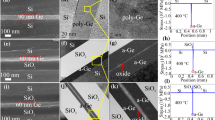Abstract
We have studied the process of reverse recovery of Si/Si1 − x Ge x heterodiodes fabricated by direct bonding of (111)-oriented n-type single crystal silicon wafers with p-type Si1 − x Ge x wafers of the same orientation containing 4–8 at. % Ge. An increase in the germanium concentration N Ge in p-Si1 − x Ge x layer is accompanied by a decrease in the reverse recovery time of heterodiodes. The presence of a sharp drop in the reverse current on the diode recovery characteristic can be explained by the existence of a narrow region with decreased minority carrier lifetime at the bonding interface (compared to carrier lifetime in the bulk), which is caused by the accumulation of misfit dislocations (generated by bonding (in this region). The results demonstrate the principal possibility of creating fast-recovery diodes based on the Si/Si1 − x Ge x heterosystem for high-power semiconductor devices manufactured using the direct bonding technology.
Similar content being viewed by others
References
G. Li, Z. Q. Liu, A. Golland, and F. Wakeman, Proceedings of the European Power Electronics Congress (EPE-2005), pp. 44–46.
Q. Y. Tong and U. Gösele, Semiconductor Wafer Bonding: Science and Technology (Wiley, New York, 1999).
I. V. Grekhov, T. S. Argunova, L. S. Kostina, et al., J. Electrochem Soc. 144, 622 (1007).
I. V. Grekhov, L. S. Kostina, T. S. Argunova, et al., Proceedings of the European Power Electronics Congress (EPE-97, November 6–8, 1997, Trondheim, Norway), pp. 2087–2092.
N. Abrosimov, A. Lüdge, H. Riemann, and W. Schröder, J. Cryst. Growth 237–239, 356 (2002).
F. Hirose, Y. Souda, K. Nakano, et al., IEEE Trans. Electron Dev. 48, 2417 (2001).
T. S. Argunova, J. W. Jung, J. H. Je, N. V. Abrosimov, I. V. Grekhov, L. S. Kostina, A. V. Rozhkov, L. M. Sorokin, and A. G. Zabrodskii, J. Phys. D: Appl. Phys. 42, 1 (2009)
E. C. Bean, Proc. IEEE 80, 571 (1992).
V. Roberts and D. W. E. Allsopp, Semicond. Sci. Tech- nol. 11, 1346 (1996).
F. Hirose, Y. Souda, K. Nakano, et al., IEEE Trans. Electron Dev. 48, 2417 (2001).
I. V. Grekhov, E. I. Belyakova, L. S. Kostina, A. V. Rozhkov, et al., Pis’ma Zh. Tekh. Fiz. 34(23), 66 (2008) [Tech. Phys. Lett. 43, 1027 (2008)].
Author information
Authors and Affiliations
Corresponding author
Additional information
Original Russian Text © I.V. Grekhov, E.I. Belyakova, L.S. Kostina, A.V. Rozhkov, T.S. Argunova, G.A. Oganesyan, 2011, published in Pis’ma v Zhurnal Tekhnicheskoĭ Fiziki, 2011, Vol. 37, No. 13, pp. 83–89.
Rights and permissions
About this article
Cite this article
Grekhov, I.V., Belyakova, E.I., Kostina, L.S. et al. Reverse recovery of Si/Si1 − x Ge x heterodiodes fabricated by direct bonding. Tech. Phys. Lett. 37, 632–635 (2011). https://doi.org/10.1134/S1063785011070078
Received:
Published:
Issue Date:
DOI: https://doi.org/10.1134/S1063785011070078




